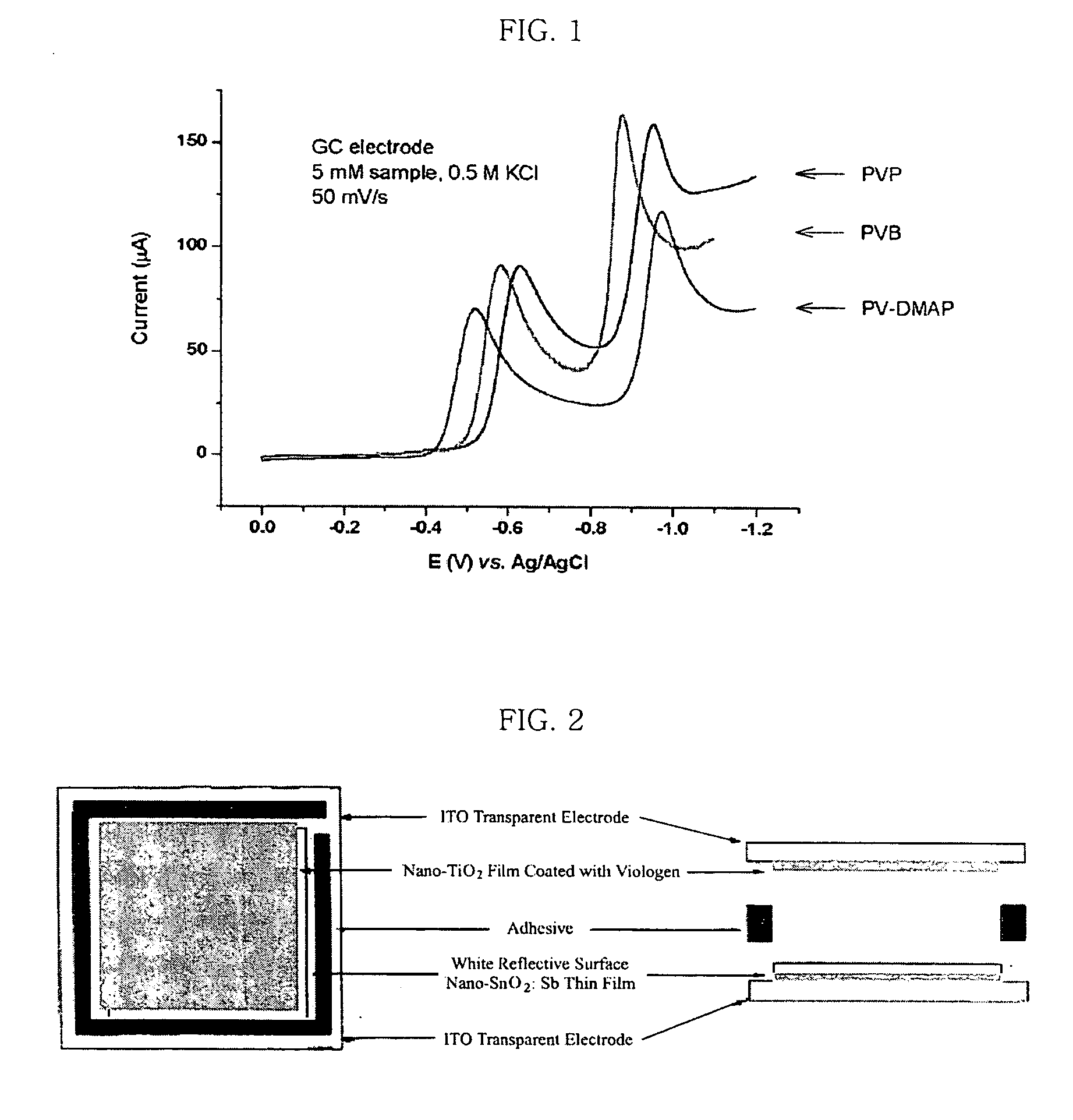Electrochromic material with improved lifetime
a technology of electrochromic materials and derivatives, applied in the direction of photosensitive materials, camera filters, instruments, etc., can solve the problems of loss of electrochromic function, chemical instability, and inability to redox in time, so as to improve the stability and lifetime of the material, increase the positive charge density, and reduce the aggregation of adjacent viologen molecules.
- Summary
- Abstract
- Description
- Claims
- Application Information
AI Technical Summary
Benefits of technology
Problems solved by technology
Method used
Image
Examples
example 1
2-((α′(4′″-N,N-dimethylpyridinium)-4″-α-)-4,4′-bipyridinium)-ethyl phosphonic acid trichloride salt (III) (PV-DMAP)
[0051]
1-(4′-Bromomethyl-benzyl)-4-dimethylamino-pyridinium bromide (I):
[0052] 30 ml of THF solution containing 1 g of 4-dimethylaminopyridine dissolved therein was added gradually to 100 ml of THF solution containing 4.32 g of dibromo-p-xylene dissolved therein at 4° C. and the mixture was reacted for 2 hours to form precipitate. After filtration, the precipitate was dried under vacuum to obtain 3.23 g of compound (I).
[0053]1H-NMR (DMSO-d6; ppm): 8.43(2H), 7.48(2H), 7.39(2H), 7.06(2H), 5.42(2H), 4.70(2H), 3.18(6H) ; MS(LC) : m / z=305 (M+).
N-(phosphono-2-ethyl)-4″-dimethylamino-pyridinium-4,4′-bipyridinium tribromide (II):
[0054] 4.60 g of compound (I) prepared as described above and 4.00 g of N-(diethylphosphono-2-ethyl)-4,4′-bipyridinium bromide were dissolved in 100 ml of CH3CN and the reaction mixture was reacted under reflux for 24 hours. After filtration, the pr...
experimental example
[0058]
[0059] The redox potentials of compound (III) in solution were measured by cyclic voltametry. Particularly, cyclic current-voltage curve was determined in aqueous 0.5M KCl solution by using a glassy carbon electrode as a working electrode, Pt electrode as a counter electrode and Ag / AgCl as a reference electrode. As shown in the following Table 1 and FIG. 1, it was possible to observe the first stage of reduction at −0.520 V (E1, reversible) and the second stage of reduction at −0.975 V (E2, irreversible).
[0060]
[0061] Ti(O-iPr)4 was hydrolyzed to form a colloidal dispersion of TiO2 nanoparticles. The nanoparticles that were initially formed had an average size of 7 nm. The nanoparticles were autoclaved at 200° C. for 12 hours to increase the average size to 12 mm. The solvent was distilled under reduced pressure to the concentration of 160 g / l. Then 40 wt % of Carbowax 20000 (poly(ethylene oxide) having an average molecular weight of 20,000) based on the weight of TiO2 was add...
PUM
 Login to View More
Login to View More Abstract
Description
Claims
Application Information
 Login to View More
Login to View More - R&D
- Intellectual Property
- Life Sciences
- Materials
- Tech Scout
- Unparalleled Data Quality
- Higher Quality Content
- 60% Fewer Hallucinations
Browse by: Latest US Patents, China's latest patents, Technical Efficacy Thesaurus, Application Domain, Technology Topic, Popular Technical Reports.
© 2025 PatSnap. All rights reserved.Legal|Privacy policy|Modern Slavery Act Transparency Statement|Sitemap|About US| Contact US: help@patsnap.com



